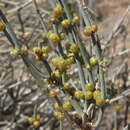Comments
provided by eFloras
Ephedra torreyana is known to form hybrids with two other species of Ephedra as reported and described by H. C. Cutler (1939). The first of these is E . × intermixta Cutler, the hybrid between E . torreyana and E . trifurca . This hybrid occurs in a small area of southwestern New Mexico (near Engle, Sierra County) within the zone of sympatry of the two parental species; it may be fertile (mature seeds are formed). It is intermediate in most characters but can be identified by its combination of the spinelike terminal buds of E . trifurca and the scabrous, light yellow seeds of E . torreyana .
The second hybrid is Ephedra × arenicola Cutler, the hybrid between E . torreyana and E . cutleri . This hybrid is known only from the type locality in extreme northeastern Arizona (near Dennehotso, Apache County) in an area of sympatry of the parental species. This hybrid is intermediate in most characters, but it can be distinguished by its combination of the setaceous leaves, viscid stems, and long-pedunculate seed cones of E . cutleri with the persistent, whorled leaves of E . torreyana .
- license
- cc-by-nc-sa-3.0
- copyright
- Missouri Botanical Garden, 4344 Shaw Boulevard, St. Louis, MO, 63110 USA
Description
provided by eFloras
Shrubs erect, 0.25--1 m. Bark gray, cracked and irregularly fissured. Branches alternate or whorled, rigid, angle of divergence about 45°. Twigs blue-green, becoming gray with age, glaucous, with numerous very fine longitudinal grooves; internodes 2--5 cm. Terminal buds conic, less than 4 mm. Leaves in whorls of 3, 2--5 mm, connate to 2/3 their length; bases becoming gray and shredded with age; apex acute. Pollen cones 1--4 at node, ovoid, 6--8 mm, sessile; bracts in 6--9 whorls of 3, cream to pale yellow, ovate, slightly clawed, 2--4 × 2--4 mm, membranous; bracteoles slightly exceeding bracts; sporangiophores 2--4 mm, exserted to 1/2 their length, with 5--8 sessile to short-stalked microsporangia. Seed cones 1--several at node, ovoid, 9--15 mm, sessile; bracts in 5 or 6 whorls of 3, obovate, 6--9 × 6--10 mm, papery, translucent with orange-yellow to greenish yellow center and base, base clawed, margins minutely dentate, undulate. Seeds 1--2(--3), ellipsoid, 7--10 × 1.5--3 mm, light brown to yellowish green, scabrous.
- license
- cc-by-nc-sa-3.0
- copyright
- Missouri Botanical Garden, 4344 Shaw Boulevard, St. Louis, MO, 63110 USA
Distribution
provided by eFloras
Ariz., Colo., Nev., N.Mex., Tex., Utah; Mexico in Chihuahua.
- license
- cc-by-nc-sa-3.0
- copyright
- Missouri Botanical Garden, 4344 Shaw Boulevard, St. Louis, MO, 63110 USA
Habitat
provided by eFloras
Coning spring. Dry rocky to sandy areas; 500--2000m.
- license
- cc-by-nc-sa-3.0
- copyright
- Missouri Botanical Garden, 4344 Shaw Boulevard, St. Louis, MO, 63110 USA
Physical Description
provided by USDA PLANTS text
Shrub, Evergreen, Dioecious, Habit erect, Trees without or rarely having knees, Primary plant stem smooth, Young shoots 3-dimensional, Buds not resinous, Leaves scale-like, Leaves whorled, Leaves mostly not photosynthetic, Non-needle-like leaf margins entire, Leaf apex acute, Leaf apex mucronulate, Leaves < 5 cm long, Leaves < 10 cm long, Leaves yellow-green above, Leaves yellow-green below, Leaves yellow below, Leaves grey-green, Leaves not blue-green, Leaf bases becoming gray and shredded with age, Scale leaves without raised glands, Scale leaf glands not ruptured, Scales leaves not or barely overlapping, Twigs glabrous, Twigs not viscid, Twigs without peg-like projections or large fascicles after needles fall, Berry-like cones copper, Bracts of seed cone included, Seeds yellow, Seeds yellow-green, Seeds wingless.
- compiler
- Stephen C. Meyers
- compiler
- Aaron Liston
- compiler
- Steffi Ickert-Bond
- compiler
- Damon Little
Ephedra torreyana: Brief Summary
provided by wikipedia EN
Ephedra torreyana, with common names Torrey's jointfir or Torrey's Mormon tea, is a species of Ephedra that is native to the deserts and scrublands of the Southwestern United States (Nevada, Utah, Colorado, Arizona, New Mexico, Texas) and to the State of Chihuahua and northern Mexico.
It was originally described by Sereno Watson in 1879 and placed in section Alatae, "tribe" Habrolepides by Otto Stapf in 1889. In 1996 Robert A. Price left E. torreyana in section Alatae without recognizing a tribe.
- license
- cc-by-sa-3.0
- copyright
- Wikipedia authors and editors

